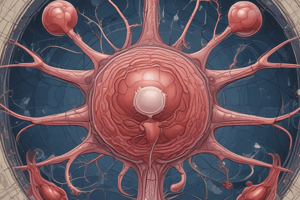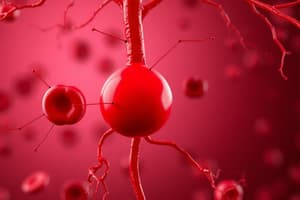Podcast
Questions and Answers
What gives blood its red color?
What gives blood its red color?
- Platelets
- Haemoglobin (correct)
- White blood cells
- Plasma
Which of the following is a function of blood?
Which of the following is a function of blood?
- Digestion
- Respiration
- Regulation (correct)
- Excretion
According to the text, what is the origin of blood cells?
According to the text, what is the origin of blood cells?
- Monophyletic theory (correct)
- Polyphyletic theory
- Both theories are correct
- None of the above
Which group of substances determines whether blood will clot or not?
Which group of substances determines whether blood will clot or not?
What happens when a blood vessel is ruptured?
What happens when a blood vessel is ruptured?
What is the molecular weight of prothrombin?
What is the molecular weight of prothrombin?
Which type of blood has a higher acidity and lower pH?
Which type of blood has a higher acidity and lower pH?
What is the main advantage of the biconcave disc shape of red blood cells?
What is the main advantage of the biconcave disc shape of red blood cells?
Which cells are responsible for the destruction of old and damaged erythrocytes?
Which cells are responsible for the destruction of old and damaged erythrocytes?
What is the pigment responsible for the red color of blood?
What is the pigment responsible for the red color of blood?
Which type of leukocyte is responsible for releasing histamine causing vasodilation?
Which type of leukocyte is responsible for releasing histamine causing vasodilation?
Which leukocyte is highly phagocytic and the most common first responder to microbial infection?
Which leukocyte is highly phagocytic and the most common first responder to microbial infection?
Which leukocyte is particularly effective with antigen-antibody complexes and releases antihistamines?
Which leukocyte is particularly effective with antigen-antibody complexes and releases antihistamines?
Which type of leukocyte has a horseshoe-shaped nucleus and is designed to degrade engulfed tissue debris from chronic inflammatory reactions?
Which type of leukocyte has a horseshoe-shaped nucleus and is designed to degrade engulfed tissue debris from chronic inflammatory reactions?
Which leukocyte is responsible for releasing histamine causing vasodilation?
Which leukocyte is responsible for releasing histamine causing vasodilation?
What is the main function of platelets?
What is the main function of platelets?
Which leukocyte is highly phagocytic and the most common first responder to microbial infection?
Which leukocyte is highly phagocytic and the most common first responder to microbial infection?
What is the process of preventing blood loss called?
What is the process of preventing blood loss called?
Which leukocyte is responsible for degrading engulfed tissue debris from chronic inflammatory reactions?
Which leukocyte is responsible for degrading engulfed tissue debris from chronic inflammatory reactions?
What causes the oxidation of iron in methaemoglobin?
What causes the oxidation of iron in methaemoglobin?
Which leukocyte is responsible for allergen and antigen response?
Which leukocyte is responsible for allergen and antigen response?
Which of the following is a characteristic of venous blood compared to arterial blood?
Which of the following is a characteristic of venous blood compared to arterial blood?
Which of the following is a characteristic of reticulocytes?
Which of the following is a characteristic of reticulocytes?
What is the fate of old and damaged erythrocytes?
What is the fate of old and damaged erythrocytes?
Which of the following is a function of macrophages in relation to erythrocytes?
Which of the following is a function of macrophages in relation to erythrocytes?
What is the pigment responsible for the red color of blood?
What is the pigment responsible for the red color of blood?
What is the main structural difference between hemoglobin and myoglobin?
What is the main structural difference between hemoglobin and myoglobin?
What is the advantage of the biconcave disc shape of red blood cells?
What is the advantage of the biconcave disc shape of red blood cells?
Which of the following substances is responsible for clot formation when a blood vessel is ruptured?
Which of the following substances is responsible for clot formation when a blood vessel is ruptured?
Which group of substances is more in number, resulting in blood not often clotting in the blood vessels?
Which group of substances is more in number, resulting in blood not often clotting in the blood vessels?
What is the molecular weight of prothrombin?
What is the molecular weight of prothrombin?
What is the molecular weight of thrombin?
What is the molecular weight of thrombin?
What is the primary function of anticoagulants in blood clotting?
What is the primary function of anticoagulants in blood clotting?
What is the primary function of procoagulants in blood clotting?
What is the primary function of procoagulants in blood clotting?
Which plasma protein can easily split into smaller compounds, one of which is thrombin?
Which plasma protein can easily split into smaller compounds, one of which is thrombin?
What is the primary function of thrombin in blood clotting?
What is the primary function of thrombin in blood clotting?
What determines whether blood will clot or not?
What determines whether blood will clot or not?
Which of the following is NOT a function of blood?
Which of the following is NOT a function of blood?
What is the difference between haemoglobin and myoglobin?
What is the difference between haemoglobin and myoglobin?
What is the difference between granulocytic and agranulocytic leukocytes?
What is the difference between granulocytic and agranulocytic leukocytes?
What is the process of haemostasis?
What is the process of haemostasis?
What is the difference between anticoagulants and procoagulants?
What is the difference between anticoagulants and procoagulants?
What is the mechanism of the blood coagulation pathway?
What is the mechanism of the blood coagulation pathway?
What are the components of the haematopoietic system?
What are the components of the haematopoietic system?
Which type of immunity provides lasting and protective immunity?
Which type of immunity provides lasting and protective immunity?
What is the primary function of phagocytes?
What is the primary function of phagocytes?
Which cells are involved in defense against parasitic infections?
Which cells are involved in defense against parasitic infections?
Which cells are responsible for triggering the complement cascade?
Which cells are responsible for triggering the complement cascade?
Which type of leukocyte is a type of antigen-presenting cell (APC)?
Which type of leukocyte is a type of antigen-presenting cell (APC)?
Which type of lymphocyte is involved in the initiation of adaptive immunity?
Which type of lymphocyte is involved in the initiation of adaptive immunity?
Which type of leukocyte is the most abundant type of white blood cells?
Which type of leukocyte is the most abundant type of white blood cells?
What is the primary function of eosinophils?
What is the primary function of eosinophils?
Which type of leukocyte is particularly effective with antigen-antibody complexes and releases antihistamines?
Which type of leukocyte is particularly effective with antigen-antibody complexes and releases antihistamines?
Which cells of the immune system are involved in recognition and clearance of foreign agents?
Which cells of the immune system are involved in recognition and clearance of foreign agents?
What are the main characteristics of the innate immune response?
What are the main characteristics of the innate immune response?
What are the physical and chemical barriers against infection?
What are the physical and chemical barriers against infection?
What is the difference between primary and secondary lymphoid organs?
What is the difference between primary and secondary lymphoid organs?
What are immune complexes?
What are immune complexes?
What is the difference between epitopes and antigens?
What is the difference between epitopes and antigens?
What is immunity?
What is immunity?
What are the functional components of the immune system?
What are the functional components of the immune system?
What are the cellular systems involved in preserving the integrity of the external and internal environment of the animal?
What are the cellular systems involved in preserving the integrity of the external and internal environment of the animal?
What is the main characteristic of innate immunity?
What is the main characteristic of innate immunity?
What are the key features of the complement system?
What are the key features of the complement system?
Which type of immunity provides a tailored response to specific pathogens?
Which type of immunity provides a tailored response to specific pathogens?
What is the primary function of phagocytes?
What is the primary function of phagocytes?
Which type of leukocyte is highly phagocytic and the most common first responder to microbial infection?
Which type of leukocyte is highly phagocytic and the most common first responder to microbial infection?
What is the primary function of eosinophils?
What is the primary function of eosinophils?
Which type of leukocyte is particularly effective with antigen-antibody complexes and releases antihistamines?
Which type of leukocyte is particularly effective with antigen-antibody complexes and releases antihistamines?
What are the primary/central lymphoid organs?
What are the primary/central lymphoid organs?
What are the secondary/peripheral lymphoid organs?
What are the secondary/peripheral lymphoid organs?
What is the primary function of neutrophils?
What is the primary function of neutrophils?
What is the primary function of mast cells?
What is the primary function of mast cells?
What is the primary function of basophils?
What is the primary function of basophils?
What are the physical and chemical barriers against infection?
What are the physical and chemical barriers against infection?
What is the main difference between the innate and adaptive immune response?
What is the main difference between the innate and adaptive immune response?
What is the primary function of phagocytes?
What is the primary function of phagocytes?
Which cells are involved in defense against parasitic infections?
Which cells are involved in defense against parasitic infections?
What is the main function of platelets?
What is the main function of platelets?
What are immune complexes?
What are immune complexes?
What is the difference between epitopes and antigens?
What is the difference between epitopes and antigens?
What is the primary function of eosinophils?
What is the primary function of eosinophils?
Which type of immunity provides lasting and protective immunity?
Which type of immunity provides lasting and protective immunity?
What are the main characteristics of the innate immune response?
What are the main characteristics of the innate immune response?
Flashcards are hidden until you start studying





